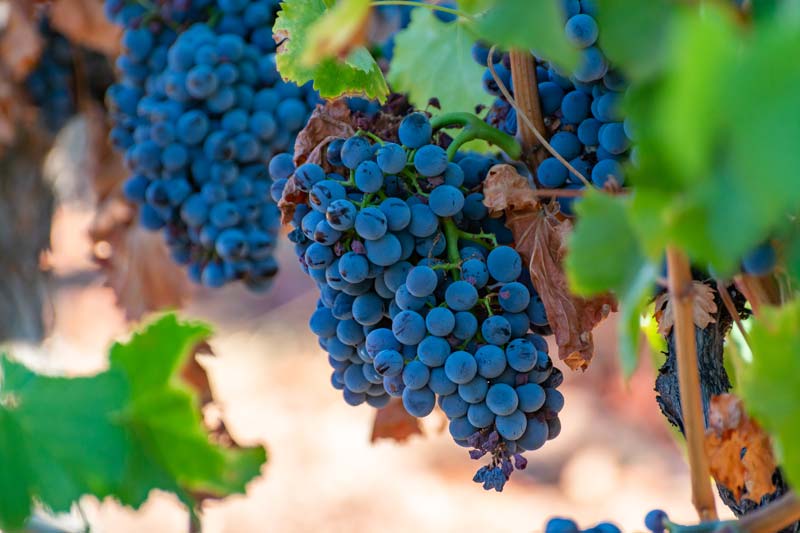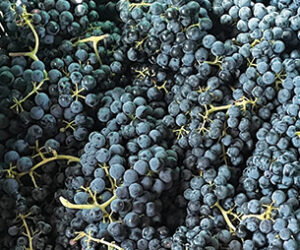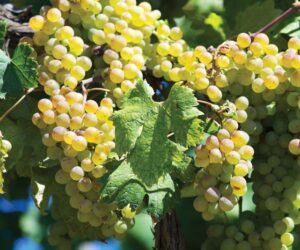Winemaking itself is an accumulation of experiences starting from our first day, and over the time that follows we build on our knowledge base. We have all had little crush pad accidents, chemical addition errors, blending mistakes, and coming up short on bottles on the magical day. Oh, this is just the tip of the iceberg. Then we sit down with our friends and many bottles of wine on the table, and start to talk about that time when something happened. In the end, you and your friends end up laughing about it. That’s the way I like to admit my mistakes . . . over wine and laughter.
I covered this grape variety before, back in the April-May 2011 issue, but I didn’t give it many positive descriptions. I told readers it was a fickle grape with poor color and tannin structure. But my opinions have changed over time with more experience, not just with our focus on this issue’s variety but also with how I approach winemaking. Our topic today is Garnacha and I am taking an alternative look at some misconceptions I may have provided readers with previously. I cannot believe I couldn’t say everything good about the variety that is one of the most abundant in the world.

Garnacha’s History
Garnacha is an old variety that has undergone many mutations. I have previously focused on Garnacha Tinta and Garnacha Blanco, but here we’ll bring in the Roja and Peluda versions as well. As the name implies, Garnacha was thought to be Spanish in origin. But, there’s always another theory when it comes to Old World varieties. On the Italian island of Sardinia it has been known as Cannonau for centuries, hence raising the speculation that it is in fact an Italian variety.
According to The Wine Bible by Karen MacNeil, both versions of the story are plausible. Without too much nitty-gritty detail, both Garnacha and Cannonau started appearing in historical records about the same time, but author Jancis Robinson leans towards its origins being Spanish in nature. Later, as it spread into France in the 18th century, it took on the French name Grenache as it was planted and grown across the south of the country.
Garnacha In The Vineyard
Viticulturally the variety is drought tolerant with early budding and late ripening, making it ideal for growing in warm, dry climates. It is a vigorous variety but sometimes this doesn’t show through when grown in sandier soils. It is susceptible to downy mildew, Phomopsis, Botrytis bunch rot, grapevine bacteria necrosis, grape moth damage, and millerandage. (In case you didn’t know, millerandage is more commonly known as shatter or coulure (FR.) where there is incomplete fruit set due to adverse weather conditions at flowering.)
The most notable blend combination is with Syrah (Shiraz) and Mourvèdre (Monastrell), more commonly known as the GSM blend . . .
Garnacha can mature with very high sugar levels while maintaining moderate acidity levels, which vary depending on the cropping level. Color can be challenged with higher crop levels. Its longevity can be attributed to its relative resistance to esca (black measles) and Eutypa dieback. It can grow in lightly acidic soils, gravel or stony soils, and soils high in limestone. It is best pruned as head-trained vines.
The Blanca (SP.) and Blanc (FR.) have the same viticultural characteristics, with the exception of mid-budding and less susceptibility to shatter. The Roja (SP.) and Gris (FR.) versions are a little more productive than Garnacha Blanca. The Peluda (SP.) version is characterized by downy undersides of the leaves; smaller, thick-skinned berries; and a little more acidity. The downy undersides help prevent heat damage to the vine by protecting transpiration and reflecting light.
The Tinta (SP.) and Noir (FR.) versions are often not seen as a varietal-labeled wine, being blended with other local varieties. The most notable blend combination is with Syrah (Shiraz) and Mourvèdre (Monastrell), more commonly known as the GSM blend, which you will find where the three grow together: France, the United States, Australia, and South Africa. You will find that all of the versions will thrive by having good placement in their local communes across France and Spain. Local AOC/AOP rules will govern how it is grown in the vineyard and made into wine across much of southern France and Spain.
From a viticulture and winemaking point of view, work with the general premise that it can be prone to large crop levels. The larger crop levels can be fine depending on the mutation. If making rosé with the Tinta and Peluda mutants then higher crop levels may be acceptable, depending on the degree of color that is desired in the final wines. You will often see rosé versions with a lighter salmon/pink version of the wine. Consider a green harvest sometime around veraison if a deeper color is desired.
Garnacha In The Winery
Due to fairly low polyphenolic concentration in Garnacha’s grape skins, all versions are reported to be susceptible to oxidation once they are in the winery. Protecting from excessive oxygen exposure and liberal use of sulfur dioxide will help push your wine towards a cleaner rendition. My general experiences with the Tinta and Blanca versions center on varietal dry red or white wines respectively.
Don’t feel the need to ferment the must hot or over-press the grapes in order to compensate for the lack of tannins. Fermenting these grapes lower and slower is generally the preferred approach.
When I was at UC-Davis I used to make up a GSM blend that the students had to try to match me on. With the wines that I was using it was very intriguing as to how little Syrah was needed to blend into the wine to give the color a big boost. The students were fooled almost every time.
Garnacha is not just limited to the dry red and white wines, it is also the basis for vin doux naturelle in southern France. The name literally translates to “wine sweet natural.” Any grape can be used for this, but locally Grenache is used for its versatility. Invented in the 13th century, the mutage process is a fortification of the wine. It involves adding a supplement of wine alcohol to the grape must in order to stop the fermentation and preserve some of the natural grape sugars.
The rules state that a neutral grape alcohol (95%) must be added. In reading the rules, it is added to the must at a minimum of 5% and maximum 10% by volume. The resulting total “alcohol richness,” a combination of the alcohol acquired and potential alcohol, can range from 15–21.5% by volume in most of the appellation d’origine protégée (AOP). There are initial Brix requirements for these wines as well; just over 25 °Brix is the minimum sugar level. I had to read the rules several times and I think I now understand them. But I believe I would most certainly make a mistake if I were to try crafting my own vin doux naturelle. At least I’ll admit it before the fact!
Garnacha Food Pairings
All versions of Garnacha pair well with a wide array of foods. As a varietal, it goes best with the lighter meats, chicken, lamb, pork, and some seafood dishes. Pairing up the Garnacha blends takes a little more thought. The more tannic GSM blends require red meat to tone down the astringency; sometimes mild cheeses will do the trick as well. You don’t want anything that will overpower the fruit characters. So strong cheeses and spicy sauces are out unless there is a bit of residual sweetness to the wine, like in a vin doux naturelle.
Coming around full circle on this article, I have left my opinion in the “room next door” and pointed out the facts as presented from my references. The column covering this variety from 2011 certainly presented some facts, but I was jaded by the versions of Garnacha I had experience with. I am a long-standing advocate of the right variety needs to be grown in the right place (OK – just a little opinion there) but returning to the facts, the fruit I was working with was not the right variety, and I was too naïve to understand that (fact . . . not opinion). There we have it . . . enjoy the wine and mea culpa.
Garnacha (Yield 5 gallons/19 L)
This is a simple way to make Garnacha from juice concentrate. Kits and fresh grapes are also available for this variety. If using a kit, be sure to consult the manufacturer’s specifications included with the kit for specific directions. If using juice concentrate, this recipe is a good guideline.
Ingredients
- (5) 46-oz. (1.36-L) cans Garnacha or Grenache juice concentrate (~68–70 °Brix)
- 3.5 gal. (13.2 L) distilled water
- 10% potassium metabisulfite (KMBS) solution (Weigh 10 grams of KMBS, dissolve into about 50 mL of distilled water. When completely dissolved, make up to 100 mL total with distilled water.)
- 5 g EC-1118 (Lallemand or Scott Labs). Red Star Premier Cuvee can be used as a substitute.
- 5 g Diammonium phosphate (DAP)
- 5 g Go-Ferm
- 5 g Fermaid K (or equivalent yeast nutrient)
- Malolactic fermentation starter culture (CHR Hansen or equivalent)
Equipment
- 6-gallon (23-L) food-grade plastic bucket for fermentation
- 5-gallon (19-L) carboy
- 1–2 one-gallon (3.8-L) jugs (optional)
- 3-gallon (11-L) carboy (optional)
- Racking hoses
- Inert gas (nitrogen, argon, or carbon dioxide)
- Ability to maintain a fermentation temperature of 70–75 °F (21–24 °C)
- Thermometer capable of measuring between 40–110 °F (4–43 °C)
- Pipettes with the ability to add in increments of 1 mL
- Clinitest® tablets to measure residual sugar
Step by Step
- Clean and sanitize all your winemaking tools, supplies, and equipment.
- If refrigerated, warm distilled water to about 65 °F (18 °C). You will use 3.5 gallons (13.2 L) to dilute the concentrate. Add five cans of the juice concentrate, using the water to completely dissolve remaining concentrate in the can. Mix well. In the end, you will have about 5.5 gallons (21 L) of juice in the bucket at about 22.5 °Brix.
- Layer the headspace with inert gas and mix Fermaid K or equivalent yeast nutrient into the juice.
- Prepare yeast. Heat about 50 mL distilled water to 108 °F (42 °C). Mix the Go-Ferm into the water to make a suspension. Take the temperature. Pitch the yeast when the suspension is 104 °F (40 °C). Sprinkle the yeast on the surface and gently mix so that no clumps exist. Let sit for 15 minutes undisturbed. Measure the temperature of the yeast suspension. Measure the temperature of the juice. You do not want to add the yeast to your cool juice if the temperature of the yeast and the must temperature difference exceeds 15 °F (8 °C). To avoid temperature shock, acclimate your yeast by taking about 10 mL of the juice and adding it to the yeast suspension. Wait 15 minutes and measure the temperature again. Do this until you are within the specified temperature range. Do not let the yeast sit in the original water suspension for longer than 20 minutes. When the yeast is ready, add it to the fermenter.
- Initiate the fermentation at room temperature (75 °F/24 °C). You should see signs of fermentation within about one to two days. This will appear as some foaming on the juice.
- Monitor the Brix and temperature twice daily during peak fermentation (10–21 °Brix). Maintain temperature between 70–75 °F (21-24 °C).
- At about 15 °Brix, dissolve the DAP in a small amount of water and add to the fermenter.
- When the wine is consistently less than 0 °Brix, inoculate with your malolactic (ML) bacteria. Check the manufacturer’s instruction on how to prepare and inoculate the malolactic bacterial culture.
- Monitor the ML fermentation using a thin layer chromatography assay available from most home winemaking supply stores. Follow the instructions included in the kit.
- When the ML fermentation is complete, add 2 mL of fresh KMBS (10%) solution per gallon (3.8 L) of wine. This is the equivalent to ~40 ppm addition.
- Place in a cool spot to settle.
- Consider adding some French and American oak chips. Do not treat the entire lot of wine. Rather break down the 5 gallons (19 L) to smaller vessels and treat one of the fractions to blend back later.
- After two weeks, test for pH and SO2. Adjust the SO2 as necessary to attain 0.8 ppm molecular SO2. (There is an SO2 calculator at www.winemakermag.com/sulfitecalculator). Check the SO2 in another two weeks and adjust. Once the free SO2 is adjusted, maintain at this level. You’ll just need to check every two months or so, and before racking.
- Rack the wine clean twice over 4–6 months to naturally clarify. Fining and/or filtration are generally not needed if SO2 levels are maintained and there are no surface films or indications of subsequent fermentations. Consult the magazine website for tips on fining and filtration if problems are evident.
- Once the wine is cleared, it is time to move it to the bottle. This would be about six months after the completion of fermentation.
- Make the project fun by having a blending party to integrate the oak fraction back into the unoaked fraction. You may not need it all, use your judgment and make what you like.
- If all has gone well to this point, given the quantity made, it can probably be bottled without filtration. That said, maintain sanitary conditions while bottling. Once bottled, you’ll need to periodically check your work by opening a bottle to enjoy with friends. Have fun!
Sulfur Dioxide Additions
The recipe calls for specific additions of sulfur dioxide at specified intervals. Once these scripted additions are made, you must monitor and maintain 30–35 ppm. Adjust as necessary using the potassium metabisulfite solution described or other methods. Testing can be done at a qualified laboratory or in your home using one of the commercially available kits.






